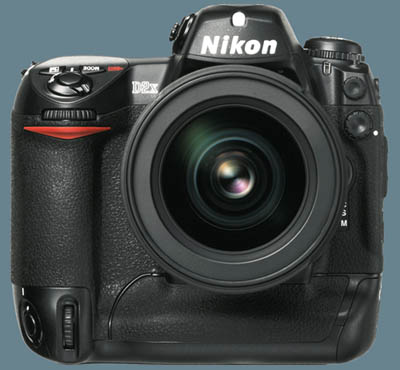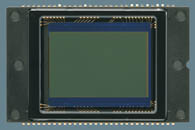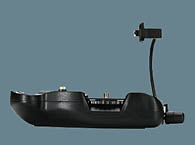




 CMOS Sensor
CMOS Sensor12.84 Million Total Pixels 12.40 Million Effective Pixels 12.21 Million Recorded Pixels ISO 100-800 (1600 / 3200) 5fps / 11 NEF (12.4MP) 8fps / 26 NEF (6.8MP) 30sec - 1/8000sec Shutter 2.5" TFT LCD Monitor Wi-Fi (802.11b / 802.11g) MSRP: $5,700.00 USD |
| Nikon D2x |
| September 26, 2004 |
| Nikon has announced their flagship DSLR, after a long silence. The D2x is still an APS-C DSLR (23.7mm x 15.7mm), possessing a brand new CMOS imager (and not LBCAST), which delivers a 12.4 eMP image. Pixel size has not been affirmed as of yet, but it is estimated to be around ~5.43Ám, which is the smallest pixel size of any DSLR.
The Sensor & Imaging Processor
12.4 Million Pixels
Only 4.3MP less than the $8,000 Canon 1Ds MK II, the D2x's 12.4MP imager is quite a beast for its size. If you do the math and make a diagram, comparing a 1Ds MK II image and a D2x image, you'll discover there is not too much of a difference. The higher the resolution you go, the many more megapixels you have to reach before a significant increase in resolution.
High Speed Crop Mode
The D2x has a feature that no DSLR has offered: faster frames-per-second due to less data being processed. The imager can now function as a 6.8MP, 8fps, high-speed sports camera, as well as a 12.4MP, 5fps high-resolution studio shooter. This is done by making a portion of the sensor "dead", so that only a smaller active area on the sensor is recording information. This smaller active area on the D2x imager, results in a 2x FOVEF (Field Of View Equivalency Factor). Basically you now have two different Focal Length Equivalencies in a single camera. This might even enable DSLR users to understand what the definition means.
Lower Resolution...More Images In The Buffer
Normally, you don't see this feature in DSLRs--even in the flagship cameras. The fps is usually fixed, and so is the buffer, no matter how small an image is selected within the camera's menus. This is because a few things are happening; either the camera manufacturer is purposely limiting the buffer due to cost restraints or marketing purposes, or the entire image is being recorded then re-sampled down to the smaller resolution.
Wi-Fi
|
| | |
 The D2x sensor is not an LBCAST sensor as some may have assumed. Nikon has outsourced this sensor from Sony (and I have said for the past year Sony is gearing up for a DSLR so get ready for it). There are still no sample images on any Nikon websites, and it is somewhat disappointing since the Canon 1Ds MK II had sample images immediately.
The D2x sensor is not an LBCAST sensor as some may have assumed. Nikon has outsourced this sensor from Sony (and I have said for the past year Sony is gearing up for a DSLR so get ready for it). There are still no sample images on any Nikon websites, and it is somewhat disappointing since the Canon 1Ds MK II had sample images immediately. Although Canon has also come out with a 802.11g device, it's MSRP is $1,250. The Nikon WT-2, which supports 802.11g, has a MSRP of only ~$630. Why the big difference? I'm currently trying to figure this one out.
Although Canon has also come out with a 802.11g device, it's MSRP is $1,250. The Nikon WT-2, which supports 802.11g, has a MSRP of only ~$630. Why the big difference? I'm currently trying to figure this one out.